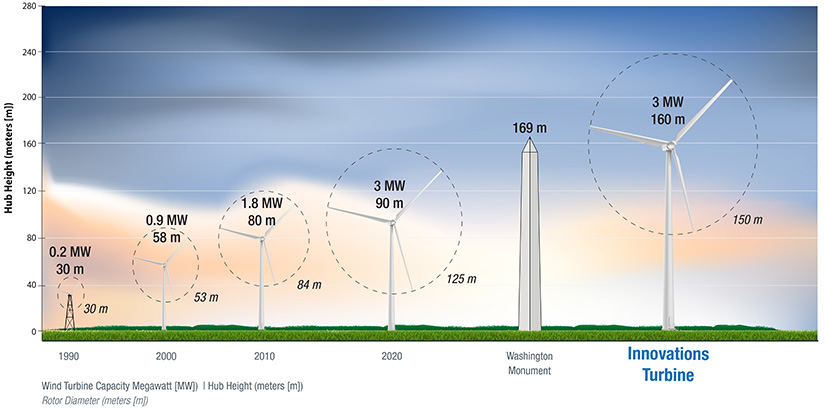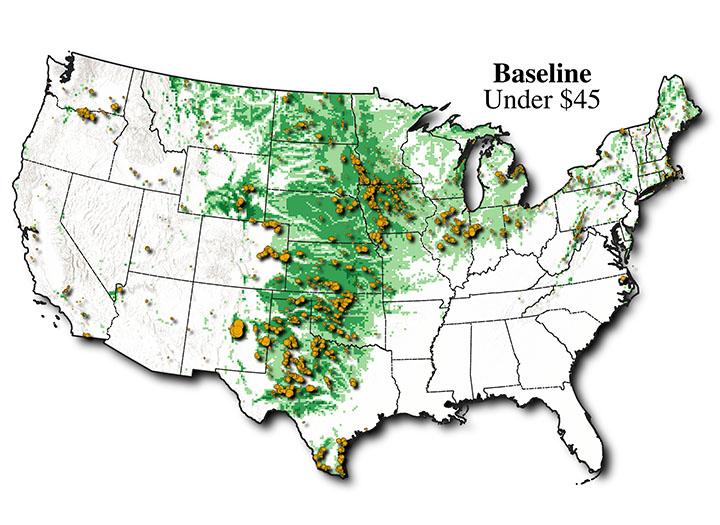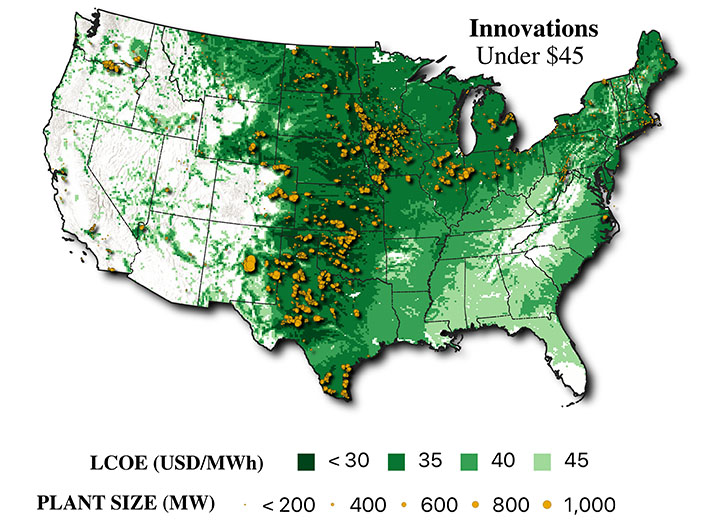Technology Advancements Could Unlock 80% More Wind Energy Potential During This Decade
Near-Commercial Wind Turbine Innovations Will Allow for Cost-Effective Wind Power in Additional Regions of the United States

While the United States has excellent wind resources over much of the country, some locations are less windy and, as a result, have not seen much wind energy development. Harnessing wind power in a cost-effective manner has long been a challenge in these areas. But new technologies could make it possible to profitably capture winds blowing higher above the ground across much of the United States.
In a recent National Renewable Energy Laboratory (NREL) study, researchers found that technology innovations making their way into commercial markets today and in coming years could unlock 80% more economically viable wind energy capacity within the contiguous United States. This could go a long way toward helping the nation meet its clean energy goals.
A significant portion of this potential wind energy occurs in regions of the United States with little or no existing wind farm deployment—the Southeast, Gulf Coast, and parts of the East Coast. These areas are close to electrical demand centers, potentially reducing the need for new transmission to deploy wind energy at the scale needed to meet renewable energy goals.
"These results show an unexpected opportunity to utilize wind power more extensively in regions where transmission infrastructure already exists or where incremental transmission could be built relatively cost effectively," said Owen Roberts, an NREL analyst and member of the study, which was funded by the U.S. Department of Energy's Wind Energy Technologies Office.
Expanding wind energy to those regions could offer additional benefits.
"Deploying wind power in these regions would reduce the need for governments and utilities to import energy from distant areas to serve local demand and would enable local jobs and local economic growth from land leases and tax revenues," Roberts said.


A recent NREL study has revealed that technology innovations could unlock an additional 80% economically viable wind energy capacity as soon as 2025. Innovations in wind technology—such as on-site manufacturing, taller towers, longer blades, and wake steering—could allow wind power plants (yellow circles on maps) to be deployed in new areas of the United States (shaded regions in second map) compared with areas that are viable with current technology (shaded regions in first map). Graphic by Travis Williams, NREL, using the U.S. Geological Survey's U.S. Wind Turbine Database
Technology Advancements Make This Possible
Wind energy technology innovations studied by NREL can reduce the cost of energy at nearly all locations in the contiguous United States and enable growing access to clean wind energy.
These innovations include:
- Longer blades. Significantly longer blades increase energy capture per turbine. Innovations to blades, like segmenting them, can make it easier to transport them, lowering turbine installation costs.
- Taller towers. Stronger winds exist at higher hub heights, beyond the reach of today's typical turbines. An average 17-meter increase in height provides the additional clearance needed for longer blades to reach those high-altitude winds.
- Low-specific-power wind turbines. These turbines have a larger rotor size relative to generator size. As bigger rotors catch more wind, they transfer more energy to the generator and increase the availability of wind power.
- Advanced tower manufacturing. Novel manufacturing techniques—such as spiral welding and 3D printing—enable on-site creation of wind turbine towers, reducing costs and avoiding transportation constraints.
- Climbing cranes. As wind turbine heights increase, cranes that enable more efficient turbine installation and major component replacements (including gearboxes, generators, and blades) could lower costs compared to conventional cranes (such as crawler or mobile cranes). This is because of higher costs to rent as well as disassemble, reassemble, and move conventional cranes between turbine sites.
- Wake steering. Using controls that tilt or turn the direction a wind turbine faces and change generator speed, plant operators can redirect (or steer) individual turbines to avoid impacting downstream turbines. This can enable existing facilities to achieve annual energy production gains of 1%–2%.
"Rather than simply continuing to build wind turbines in already-developed regions of the country, this study shows that we can expand wind energy into areas of the country where we historically haven't seen it," said NREL researcher Travis Williams, who participated in the study. "Innovations, especially low-specific power and taller towers combined with modest cost reductions, could dramatically increase wind energy's potential in the United States."
Work Is Still Needed To Capture This Potential
The study's results, published in a technical report titled Exploring the Impact of Near-Term Innovations on the Technical Potential of Land-Based Wind Energy, reveal an opportunity for the United States to use wind power more extensively when meeting renewable energy targets. To realize the full potential of these technological advancements, more work remains.
For instance, policymakers can play a critical role in reducing other barriers, such as increasing public knowledge of or experience with wind energy, utility experience with integrating wind power (which may not be a consistent supply), workforce capabilities, and developer experience in regions with new wind energy markets.
"We're talking about bringing a new industry and new technology to parts of the United States that have hardly seen wind energy," Roberts said. "The more we can show there's potential, the more people will understand the opportunity—creating more pathways to meet our national energy goals."
Learn more about NREL's land-based wind energy research. And be sure to subscribe to NREL's wind energy newsletter for more news like this.
Last Updated May 28, 2025
